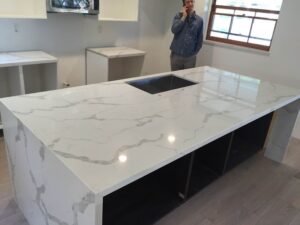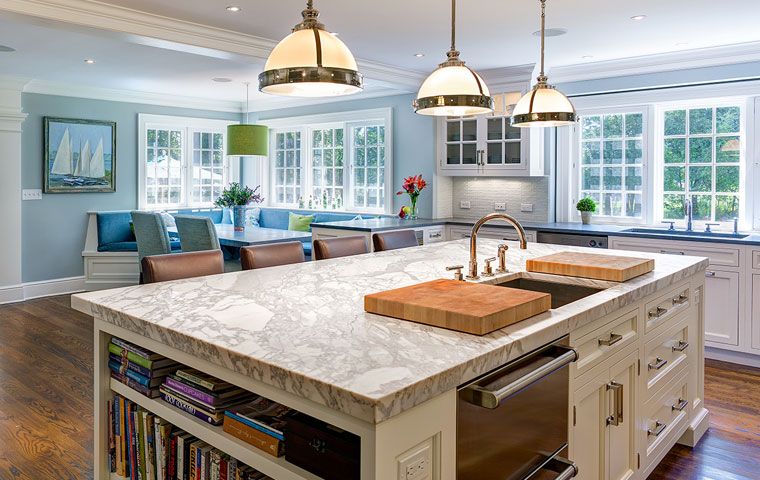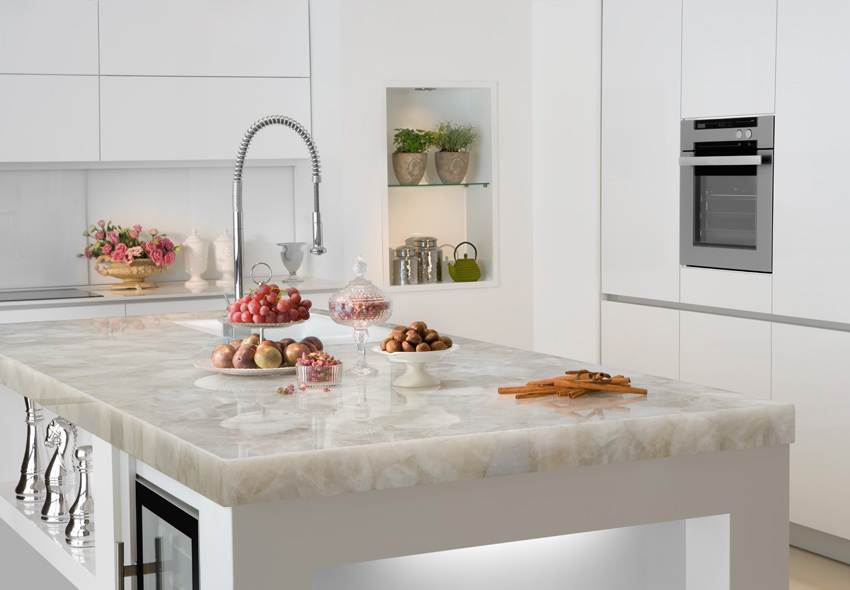Quartz countertops look like a single piece of sleek, seamless stone, yet every slab hides a high-tech recipe of geology, chemistry, and heavy engineering. Below is a start-to-finish tour that demystifies how raw quartz rock becomes the gleaming, low-maintenance surface you see in modern kitchens and baths. Whether you’re a homeowner, designer, or curious DIYer, this 1 300-word guide—written from a decade of countertop-industry experience—explains each stage, key materials, evolving safety rules, and the sustainable innovations shaping the next generation of engineered stone.
Table of Contents
- The Rise of Engineered Quartz
- Step 1: Sourcing and Selecting Quartz Raw Materials
- Step 2: Crushing, Screening, and Grading
- Step 3: The Resin and Additive Blend
- Step 4: Mixing and Pigment Dispersion
- Step 5: Vibrocompression Vacuum Molding
- Step 6: Curing—Heat Meets Chemistry
- Step 7: Cooling, Trimming, and Calibrating
- Step 8: Polishing and Texture Finishing
- Quality Assurance and Slab Grading
- Health, Safety, and the Silica Conversation
- Sustainability and 2025 Manufacturing Innovations
- Key Takeaways
1 | The Rise of Engineered Quartz
Engineered quartz entered the market in the late 1980s as an answer to the porous nature of natural stone and the visual monotony of solid-surface plastics. By binding ground quartz—one of Earth’s hardest minerals—with polymer resins, manufacturers achieved a non-porous, stain-resistant slab that boasts the realism of stone plus the easy care of laminate, with no annual sealing required. In 2025, quartz claims roughly 45 percent of the U.S. countertop market, outranking granite and laminate in new-construction homes.
2 | Step 1: Sourcing and Selecting Quartz Raw Materials
• Quarry mining: Quartz is mined from open-pit deposits on nearly every continent. High-purity white quartz comes from Spruce Pine (North Carolina), Bahia (Brazil), and Rajasthan (India). Darker crystal and semi-translucent varieties add depth or sparkle.
• Recycled content: Post-consumer glass, mirror chips, porcelain shards, or pre-consumer industrial quartz fines are added to many eco-lines. Recycled content may range from 15 percent to 70 percent, depending on brand and color series.
• Specification targets: Silica content of 90 percent or higher for hardness; iron, mica, and feldspar kept below 0.1 percent to avoid discoloration during curing; moisture below 0.05 percent for optimal resin adhesion.
3 | Step 2: Crushing, Screening, and Grading
Quartz blocks are processed in several stages:
- A primary jaw crusher breaks fist-size blocks into pieces one to two centimeters across.
- Cone crushers and vertical-shaft impactors reduce these fragments to sands as fine as 0.4 millimeters.
- Vibratory screens then classify the grains into coarse (2–5 mm), medium (0.5–2 mm), and fine (below 0.5 mm) fractions. A precise particle-size distribution is crucial; too much fine dust weakens slabs, while excess gravel leaves voids.
4 | Step 3: The Resin and Additive Blend
Quartz powder alone cannot form a slab. The “glue” is an engineered polymer-resin matrix that typically includes:
Component | Purpose | Typical Share by Weight
Unsaturated polyester or bio-epoxy resin | Binds quartz grains and provides flex | 6–8 percent
Accelerator (for example, MEKP) | Initiates polymerization | 0.2–0.4 percent
Ultraviolet stabilizers | Protect color from sunlight | Trace
Pigments and dyes | Impart solid colors or marble veining | 1–2 percent
Antimicrobial agents (optional) | Inhibit bacterial growth | Less than 0.1 percent
In 2025 many European brands replace up to half of the petro-based resin with castor-oil-derived bio-polyols to cut carbon footprints.
5 | Step 4: Mixing and Pigment Dispersion
A planetary mixer blends the graded quartz aggregates with liquid resin, pigments, and any decorative chips such as glass or mirror flakes. The mixing runs under vacuum to prevent trapped air bubbles, lasts one and a half to three minutes, and uses computer-vision systems to adjust pigment doses for consistent coloration.
6 | Step 5: Vibrocompression Vacuum Molding
The Bretonstone process, now industry standard, works as follows.
• Mold loading: The quartz-resin slurry is dumped onto a rectangular mold (about 306 × 144 cm for a jumbo slab). A spinning screed bar levels the mass to a uniform thickness of 1.2, 2, or 3 cm.
• Vacuum and vibration: A sealed chamber lowers pressure to under 100 mbar while vibration at roughly 4 000–5 000 rpm compacts the mix and drives out residual air.
• Compression: A 100-ton hydraulic press then densifies the slab to about 2.4 g/cm³, locking grains into an interlocking matrix similar to natural stone.
7 | Step 6: Curing—Heat Meets Chemistry
The pressed slab enters a curing oven at 90–110 degrees Celsius for 30–45 minutes. Heat triggers full polymerization of the resin and increases flexural strength to 40–70 megapascals (granite averages 12–20 MPa). After curing, slabs cool on racks for 24 hours to relieve internal stresses.
8 | Step 7: Cooling, Trimming, and Calibrating
• Edge-trim saws square rough edges and cut each slab to exact sales dimensions, such as 126 × 63 inches.
• Calibrating grinders plane the back side to keep thickness tolerance within ±0.3 millimeters.
• A laser engraves batch codes and lot numbers for traceability.
9 | Step 8: Polishing and Texture Finishing
Automated polishers run eight to twelve resin-bond diamond heads, graduating from 50 grit up to 3 000 grit.
• Gloss finishes reach 55–70 gloss units.
• Honed or matte finishes stop at about 400 grit and receive a brushing pass for a soft appearance.
• Leathered textures employ oscillating diamond brushes to create an anti-glare, tactile surface popular in 2025 farmhouse designs.
10 | Quality Assurance and Slab Grading
Each slab undergoes visual inspection under color-correct lighting, mechanical testing on random samples, and laser dimensional checks. Slabs are graded A, B, or commercial grade. Premium A-grade pieces carry the longest warranties and command the highest showroom prices.
11 | Health, Safety, and the Silica Conversation
Quartz dust contains respirable crystalline silica, which can cause silicosis when inhaled. Modern plants control exposure by using wet grinding, closed conveyors, central HEPA-filtered vacuum systems, real-time silica monitors, and personal protective equipment. Some manufacturers are piloting low-silica quartz with 50 percent or less crystalline silica, reducing dust toxicity for downstream fabricators.
12 | Sustainability and 2025 Manufacturing Innovations
Trend | Why It Matters | Example
Bio-based resins | Reduce fossil-carbon emissions by 30–60 percent | Castor-oil polyols
Recycled water loops | Save tens of millions of gallons per year in large plants | Membrane filtration and UV sterilization
Solar process heat | Matches 90–110 °C oven temperatures | Concentrated solar thermal arrays
In-line defect AI | Lowers scrap rates by around 15 percent | Machine-learning cameras flag pigment streaks in real time
Slab-as-a-Service | Creates closed-loop recycling for end-of-life slabs | Take-back programs grind old slabs into new filler
13 | Key Takeaways
• Engineered quartz combines roughly 93 percent ground quartz with polymer resins, pigments, and additives, producing a non-porous, durable slab.
• Vibrocompression vacuum molding densifies the slurry under high pressure and low air pressure to form each slab.
• Curing, trimming, and multi-stage polishing turn the pressed mass into the glossy, vein-rich surface seen in showrooms.
• Modern plants prioritize worker safety through stringent silica-dust controls and are adopting greener technologies such as bio-based resins and recycled water systems.
Understanding the journey from quartz crystal to countertop helps homeowners appreciate the material’s engineering pedigree and explains its price point. It also empowers designers and fabricators to ask smarter questions about safety, performance, and environmental impact as the next generation of engineered stone continues to evolve.


